| Srl | Item |
| 1 |
ID:
151145
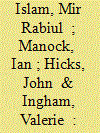

|
|
|
|
|
| Summary/Abstract |
Two million people were affected in the floodplains and low-lying areas in Sirajgang in 2012. Seven hundred and fifty families were made homeless and forced to live in small temporary huts on the river protection embankments. Unemployment rose alarmingly and the jobless left their villages to find work in larger cities, leaving behind their vulnerable and insecure families. Consequently, women were increasingly required to take on totally unfamiliar roles. Our research utilised in-depth interviews with women managing without the support of their husbands. Key findings highlighted that community resilience would improve if these women were engaged at the local operational level of disaster management.
|
|
|
|
|
|
|
|
|
|
|
|
|
|
|
|
| 2 |
ID:
086000
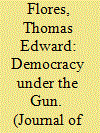

|
|
|
|
|
| Publication |
2009.
|
| Summary/Abstract |
Increasingly, scholars studying civil conflicts believe that the pace of postconflict economic recovery is crucial to a return to peaceful politics. But why do some countries' economies recover more quickly than others'? The authors argue that the inability of politicians to commit credibly to postconflict peace inhibits investment and, hence, slows recovery. In turn, the ability of political actors to eschew further violence credibly depends on postconflict political institutions. The authors test this framework with duration analysis of an original data set of economic recovery, with two key results. First, they find that postconflict democratization retards recovery. Second, outright military victory sets the stage for a longer peace than negotiated settlements do. This research deepens the understanding of the bases of economic recovery and conflict recidivism in postconflict countries and points to future research that can augment this knowledge further still.
|
|
|
|
|
|
|
|
|
|
|
|
|
|
|
|
| 3 |
ID:
192139
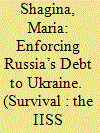

|
|
|
|
|
| Summary/Abstract |
As Russia continues to wage war against Ukraine, Western calls to confiscate Russian frozen assets to aid Ukraine’s reconstruction have become more urgent. Whether justice on this score will be ultimately delivered remains unclear. Despite many international initiatives to seize Russian assets, legal conservatism and concerns over the disruption of international rules are strong constraints. Finding a legal way to confiscate Russian sovereign assets will require political determination, international coordination and legal creativity.
|
|
|
|
|
|
|
|
|
|
|
|
|
|
|
|
| 4 |
ID:
148709
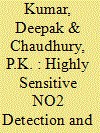

|
|
|
|
|
| Summary/Abstract |
Low cost; easy to fabricate and flexible single wall carbon nanotubes thick film resistor (SWNT-TFR) for detailed study of NO2 detection is reported. SWNT-TFR was fabricated by vacuum filtration technique on flexible polycarbonate membrane. SWNT-TFR sensor shows selective response to NO2. The response increases from 1.47 per cent to 17.34 per cent with increasing the NO2 concentration from 0.2 ppm to 10 ppm, respectively. Different energy sources, IR, thermal and UV were explored for achieving fast recovery of the SWNT-TFR sensor. The results showed that the gas sensor gives immediate and fast recovery in the presence of UVC light. The calculated detection limit is less than 764 ppt for NO2. We are also presenting sensing of dimethyl methylphosphonate (DMMP) as a simulant of sarin. SWNT-TFR gives repeatable response of ~2.7 per cent for 500 ppm of DMMP. This work suggests the possibility to utilise SWNTs-TFR as NO2 sensors for air-quality monitoring.
|
|
|
|
|
|
|
|
|
|
|
|
|
|
|
|
| 5 |
ID:
148293
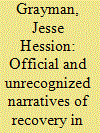

|
|
|
|
|
| Summary/Abstract |
Anthropological analyses of post conflict narratives reveal how strategic interests mobilize to resolve or perpetuate conflict. Three years after the 2005 Helsinki peace agreement between the Government of Indonesia and the Free Aceh Movement (GAM) that ended GAM’s thirty-year separatist rebellion, the author led a post conflict programming evaluation. Drawing upon qualitative interviews of rural informants for this study and using an anthropological approach to narrative analysis, this article argues that recovery narratives can be understood in terms of official and counter-official discourses, each utilizing strategic resources to amplify their interpretation of an unfolding peace process. Subaltern narratives heard most clearly are empowered because they adhere to narrative conventions proscribed by the peace agreement and other powerful discourses such as GAM’s separatist ideology. Other unrecognized voices are left out; their stories of recovery resist easy interpretation and sidestep clichéd narratives of peace.
|
|
|
|
|
|
|
|
|
|
|
|
|
|
|
|
| 6 |
ID:
152802


|
|
|
|
|
| Summary/Abstract |
UK policies embrace the ideas of security–development nexus, but most scholarship on its engagement builds upon African cases. This paper examines the drivers, nature and implications of UK involvement with an Asian country, Nepal. The UK’s position as the largest bilateral contributor and major peace and security donor among at least 21 others makes examination of its Nepal involvement imperative. This paper uses the grounded theory method and interpretivist analytical approach to create interactions between published and field information. Although the UK’s persistent engagement and programme-based approach helped peacefully manage transition, this paper contends, institutional changes have been shallow and winning confidence remains strenuous
|
|
|
|
|
|
|
|
|
|
|
|
|
|
|
|
| 7 |
ID:
174223


|
|
|
|
|
| Summary/Abstract |
Whereas there is a consensus on the significance of rebuilding conflict-torn states and societies, there is no agreement on how it should be done. The dominant framework of post-war rebuilding is clearly biased to rebuilding the ‘hardware’. This article argues that the government’s attempt to rebuild the Rwenzori sub-region in the aftermath of the Allied Democratic Forces war adopted the conventional approach that pays less attention to rebuilding ‘software’. It further asserts that the recovery programme was symbolic given that government wished to avoid the political consequences of not taking action at all. Symbolism not only led to flawed performance of the recovery programme but also negatively affected peace building in the sub-region. The article advocates not only for a synergy of rebuilding ‘hardware’ and ‘software’ but also for a nuanced approach that triangulates top-down and bottom-up approaches at all stages of post-conflict recovery.
|
|
|
|
|
|
|
|
|
|
|
|
|
|
|
|